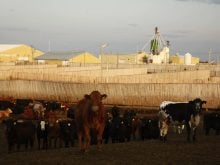This cattle market information is selected from the weekly report from Canfax, a division of the Canadian Cattlemen’s Association. More market information, analysis and statistics are available by becoming a Canfax subscriber by calling 403-275-5110 or at www.canfax.ca.
Fed market steady
Continued large harvests and improved beef buying interest were supportive last week, but ample captive supplies limited the cash market upside. Buying interest was lacklustre but all three major packers bought cattle.
Read Also

Huge Black Sea flax crop to provide stiff competition
Russia and Kazakhstan harvested huge flax crops and will be providing stiff competition in China and the EU.
Light to moderate volume trade was steady with the previous week at $275 per hundredweight delivered. Live trade saw prices at $161.50 per cwt. Kill dates were spread across the first three weeks of May.
Western Canadian fed slaughter for the week ending April 2 surged 11 percent larger than the previous week to 47,194 head, and year-to-date volume was six percent larger at 551,770 head. Canadian fed slaughter last week was the second largest seen for 2022 at 59,064 head. Canadian fed cattle/cow exports to the United States for the week ending March 26 were generally steady with the previous week at 11,607 head, and year-to-date export volume was up eight percent to 128,993 head.
In Ontario, large forward-priced slaughter supplies limited the cash market upside. Ontario trade stayed range-bound at $290-$293 per cwt. delivered.
Except for the ongoing Ukraine invasion, outside market influences stabilized last week and seasonality should return to the fed market. With improved grilling and food service demand and warmer weather, beef prices should strengthen, pulling fed cattle through the beef pipeline in April.
In the United States, light live trade in the south was steady with the previous week at US$138 per cwt. Northern live trade was comparable with the previous week from $138-$140. Steer carcass weights for the week ending March 26 eased six pounds lower than the previous week to 910 lb. and were nine lb. lighter than year ago. Last week’s total U.S. slaughter was estimated at 676,000 head, up six percent from the previous week.
Cow prices strengthen
D2 slaughter cows traded 82 cents stronger last week at $97 per cwt. and were $9 per cwt. higher than last year. D3 cows were 70 cents softer at $86 per cwt. but remain $6.63 per cwt. higher than last year.
In 2021 and the five-year average, D2 cow prices peaked in June at $103 per cwt. and $98 per cwt., respectively, after a March to June rally. Over the last month, live exports of fed cattle and cows have gone from being steady with a year ago to up eight percent year to date.
Weekly volumes have been 18-31 percent above year ago levels. The female to male disposal ratio dropped from 1.18:1 in January to 1.13:1 in February 2022 with reduced cow slaughter but remains above February 2021’s 1.06:1.
Butcher bull prices were steady at $121 per cwt. Exports of slaughter bulls from the West jumped to 1,105 head for the week ending March 26 from 480 head the previous week.
Feeder prices soften
Alberta feeder prices were $1 per cwt. softer last week on volumes 17 percent larger than the same week last year. The greatest pressure was on 500-600 weights, which were down $3.25-$3.50 per cwt. from the previous week. Steers remained $1 per cwt. higher than last year and heifers are $2.25 per cwt. softer than last year.
While heavier 600-900 lb. heifer prices remained $1-$5 per cwt. above last year’s levels, lighter weight 300-600 lb. heifers tracked below a year ago. Heavy steers 500-900 lb. were $1-$9 per cwt. above last year, while the lighter 300-500 lb. categories were only $2-$6 per cwt. below last year.
Auction market volumes at 19,768 head were down 33 percent from the previous week but up 17 percent from last year. Live cattle imports in February 2022 were 13,060 head, down 56 percent from February 2021 and are the smallest since February 2019. Monthly imports have been below year ago levels since November.
In 2021, 500-600 lb. steer prices were choppy between April and June, ranging between $228 and $236 per cwt. Expect a similar pattern this year because spring rain over the next eight weeks will determine grass availability. Continued volatility in the grain market influences what feedlots are willing to pay.
U.S. cutout mixed
In U.S. beef trade, cut-out values were mixed with Choice up US$3.01 per cwt. to average $271.40 and Select down $1.12 per cwt. to average $261.22.
















